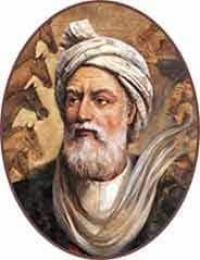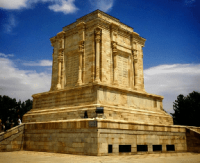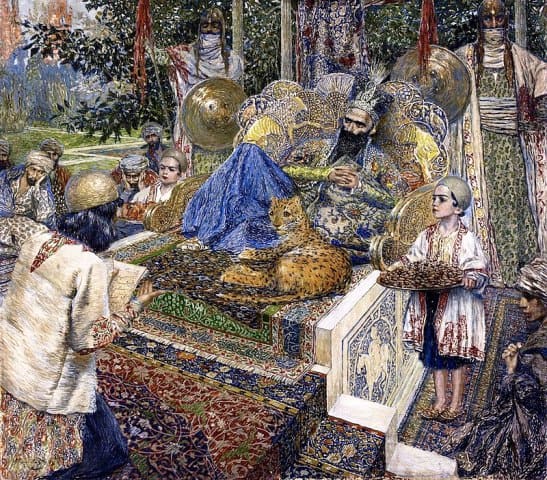You are here
Abulkasim Firdousi.


Photo tours of architectural sights of Tajikistan.
"I have built with my poetry a high castle, which will not be damaged by wind and rain. Years will pass over this book, and every smart person will read it ... I will not die, I will live, because I sowed the seed of the word."
Abulkasim Firdousi.
Drive from Dushanbe to Yaghnob Gorge.
Hakim Abulkasim Firdowsi Tusi (935 - 1020) - Persian poet, classic of Persian literature, author of the epic poem "Shahnameh" ("Book of Kings"). He is popular and is considered a national poet in Iran, Tajikistan and Afghanistan.
Ferdowsi lived in the 10th century on the territory of Greater Iran (Greater Persia), in Khorasan. Three centuries earlier, in the 7th century, Sasanian Persia was conquered by the Arabs and became part of the Caliphate.
During the time of the central authority of the caliph, the Persian language and culture were supplanted by Arabic ones, but by the end of the 9th century the caliphate weakened and local Muslim dynasties (the so-called Iranian intermezzo) came to power.
Firdousi lived under two of them - in the Samanid and Gaznevid states. Firdowsi comes from a family of dekhkans, Persian landowners who prospered in the pre-Islamic times of the Sassanid state, but whose influence waned under the Caliphate.
The dekhkans were patriotic and considered it their duty to preserve the cultural traditions of Persia, including the legendary stories about Iranian kings. he Samanids, who controlled the city of Tus, where Firdousi was born, also promoted Persian culture; they considered themselves descendants of the Sasanian general Bahram Chubin.
The Samanid bureaucracy used New Persian instead of Arabic, and the Samanid elite ordered translations of texts from Pahlavi, Persian, the former literary language of pre-Muslim Iran, into New Persian. In particular, the Samanid governor of Tus Abu Mansur Muhammad ordered several local authors to write the poem Shahnameh (Book of Kings, completed in 957), which became one of the sources for Ferdowsi's Shahnameh.
There is almost no information about Firdousi's childhood and youth. He received a good education for that time. It is not known for certain whether Firdowsi knew Arabic and Pahlavi. His poetic name Firdousi is translated as "heavenly".
He highly valued knowledge: “Look for the path to sensible words, go through the whole world to gain knowledge” and received the nickname “khakim” (“wise man”, “scientist”) for the depth and breadth of his knowledge.
For a long time, Firdousi lived in Ghazni, on the territory of modern Afghanistan, where he was in the service of the padishah Mahmud Ghaznevi (to whom he dedicated the Shahnameh). However, the idea of the poem that only the hereditary bearers of royal power have the right to it did not please Sultan Mahmud, who was more satisfied with the legitimacy of force rather than heredity.
It is known that in 970 Firdowsi had a son, so presumably he was married. It is believed that one of the women mentioned in the Shahnameh is his wife. This woman also came from a family of farmers, knew how to read and write, played the harp and received a good education.
Ferdowsi was buried in the city of Tus in his own garden, as the local religious authorities did not allow him to be buried in the city cemetery. The governor of the province of Khorasan ordered the construction of a mausoleum over the grave of Ferdowsi, after which this place became an object of mass worship.
Subsequently, the burial place fell into disrepair. It was restored by order of Reza Shah to the millennium from the birth of the poet, in the period 1928 - 1934. The restoration was carried out by the Iranian National Heritage Society, after which the tomb of Ferdowsi was elevated to the rank of Iranian national shrine.
Ferdowsi transferred the ideas of ancient Iran to Islamic Persia and contributed to the spread of the Persian language. He also helped to preserve the Iranian identity in conditions when it was threatened by Arabization - although activity in this direction began before him, it was he who brought it to completion.
Ferdowsi became one of the main poets of classical Persian literature of the 10th-15th centuries, the period before the division of Persian literature into Iranian and Tajik literature proper. In Soviet and post-Soviet historiography, he is regarded as a Persian-Tajik poet.
The only work of Ferdowsi whose authorship is indisputably established is the Shahnameh (Book of Kings), the national epic of the Iranian peoples. The Shahnameh describes the history of Iran from ancient times to the Islamic conquest of Persia in the VIIth century.
The poem consists of 50,000 couplets and is considered the longest poem written by a single author: twice the length of the Iliad and the Odyssey combined. Perhaps Firdowsi wrote poetry in his youth, but they have not survived to this day.
For some time, Firdousi was also credited with the poem “Yusuf and Zuleikha” based on the same story, the biblical-Quranic story about Joseph, but the modern scientific community denies his authorship. here is also controversy in research circles about a satirical poem, allegedly by Firdowsi, in which the poet ridiculed Padishah Mahmud Ghazni for not properly rewarding the work of the poet.
Firdowsi's early biographer Nizami Aruzi claimed that the entire text of this poem, except for six lines, was destroyed by a well-wisher who specifically bought this poem from Firdowsi for a thousand dirhams. A number of fragments of the Shahnameh text are similar to satirical verses; some scholars consider them fabricated, others tend to regard them as genuine creations of Ferdowsi.
According to a legend, which has no exact confirmation, padishah Mahmud Gaznevi refused to pay Firdousi for the poem. This greatly annoyed the poet, and he wrote a satire in which he reproached the padishah for descending from a slave.
As a result of the anger of the ruler, Ferdowsi was forced to flee the country and wander in poverty for the rest of his life. There is a legend that shortly before the death of Firdowsi, Padishah Mahmud accidentally heard from one courtier an expressive verse from the Shahnameh, inquired about the author and found out that the verse was from the “Book of Kings” dedicated to Mahmud by the famous Firdowsi, who now lives in poverty in Tus.
Mahmud immediately ordered that a rich gift be sent to Tus for Ferdowsi. But, according to this legend, Firdowsi died shortly before that: at the very time when his body was carried out for burial through one city gate, camels with gifts from Mahmud entered the other city gates.
As Iranika notes, the modern use of the word "Tajik" was distorted in Soviet and Tajik academic discourse in favor of Soviet national politics and Tajik nationalism. Historically, Tajikistan did not exist as a separate entity and appeared only as part of the USSR, at the same time, intense disputes began about the identity of the Tajiks.
Tajik nationalism began to claim Tajikistan's priority in Persian literature. In the 1930s, the issue of the origin of the Shahnameh became central to the debate about Tajik identity. In 1941, Joseph Stalin called the Tajiks "the oldest of the peoples of Central Asia", who "gave birth to the great poet Ferdowsi".
In most Soviet scientific works, Persian literature began to be called "Persian-Tajik". The main supporters of this transformation were the Tajik writers Sadriddin Aini and Bobodzhan Gafurov. Gafurov also argued that the oldest texts of the Avesta were written by the predecessors of modern Tajiks and that it was the peoples of Iran who absorbed the culture of the peoples of Central Asia, and not vice versa.
He insisted that writers and philosophers considered Persian, such as Ferdowsi, Al-Biruni or Rudaki, should be considered "Persian-Tajik". This approach was fully consistent with the Soviet ideology and national policy.
The characterization of Ferdowsi as a Persian poet became the reason for accusations, in particular against Abdulkasim Lahuti. In 1948, Evgeny Bertels made an attempt to abandon the territorial and ethnic approach in Iranian philology.
He published an article "Literature in Persian in Central Asia", in which he proceeded from the idea of the integrity of Persian literature, stating that he would understand as such all works "written in the so-called. "New Persian language", regardless of the ethnicity of their authors and the geographical point where these works arose.
Among the Persian poets, Bertels also wrote about Firdousi. Bertels' speech immediately turned him into an object of politicized criticism for switching to "the erroneous positions of Western European Orientalists."
“Find out the ethnicity of each noteworthy author, and then classify them into different literatures - but such a task, firstly, would be impracticable because we have no data on the ethnicity of the old writers and probably never will; secondly, it would be methodologically vicious to the very last extreme.
Consequently, we would then build literature on the basis of blood, on the basis of race. It is hardly necessary to say that we cannot and will not build literature in this way, I, in any case, will not, if someone else wants - please, his private business (...).
Frankly speaking, I don't know how to draw a division between Persian and Tajik literature. If we take the position that we must necessarily attribute the writer to the place where he was born and where he worked most of his life, then this principle will not lead us anywhere.”.
- Archival fund of MG IV of the USSR Academy of Sciences. Cit. Quoted from: Iranian studies in Russia and Iranian studies. The Russian Academy of Sciences. Institute of Oriental Studies. (Executive editor L. M. Kulagina). M. IV RAN, 2001. p. 184.
Bertels tried to defend his position, stating the methodological absurdity of classifying writers according to their ethnic or territorial affiliation, but after new accusations from colleagues of reactionary pan-Iranism and bourgeois cosmopolitanism, he was forced to admit his "major mistakes".
By the end of the 1930s in the USSR, Shahnameh began to be defined not as a Persian poem, but as a Persian-Tajik or simply Tajik. Later, the image of Firdousi became one of the symbols of Tajik nationalism.


Authority and photos:
https://ru.wikipedia.org/wiki/%D0%A4%D0%B8%D1%80%D0%B4%D0%BE%D1%83%D1%81%D0%B8







